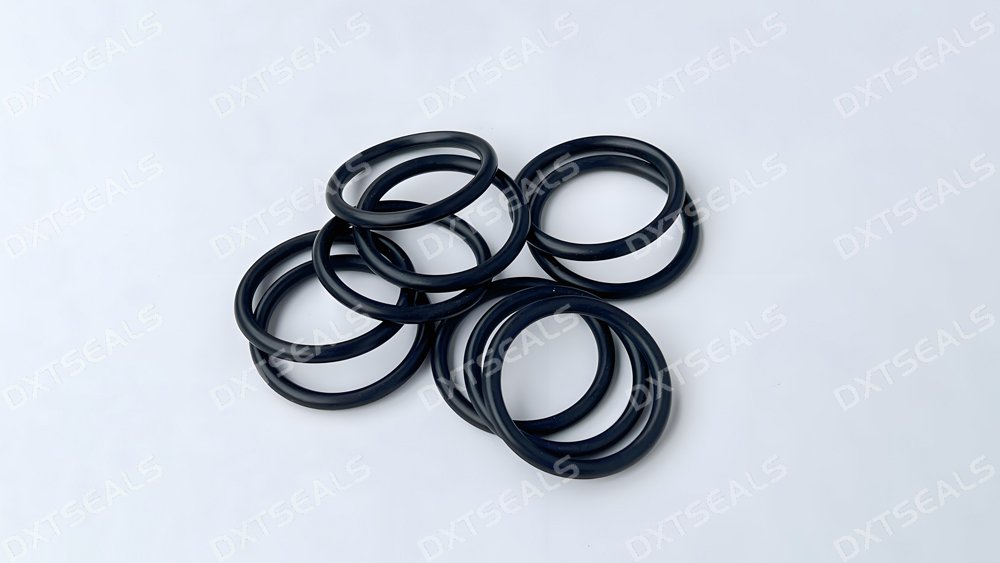
In industrial applications where oil exposure is constant—such as automotive, hydraulic systems, and heavy machinery—choosing the right rubber material for seals and gaskets is critical. Two of the most widely used oil-resistant rubber types are NBR (Nitrile Butadiene Rubber) and FKM (Fluorocarbon Rubber, e.g., Viton®). But which performs better in oily environments?
This article by DXTSEALS compares NBR and FKM, their oil resistance, temperature range, and common uses, helping you make an informed material selection.
🔍 What Is NBR (Nitrile Rubber)?
NBR is a synthetic rubber derived from acrylonitrile and butadiene. It is known for:
-
Excellent resistance to petroleum-based oils and fuels
-
Good mechanical strength
-
Affordability
Temperature Range:
-
Typically -40°C to +100°C
-
With special formulations, up to 120°C
Pros:
-
Cost-effective
-
Good abrasion and tear resistance
-
Ideal for automotive and hydraulic applications
Cons:
-
Poor resistance to ozone, UV, and weathering
-
Limited high-temperature capability
🔍 What Is FKM (Fluorocarbon Rubber)?
FKM, often recognized by the brand name Viton®, is a high-performance elastomer with a fluorinated polymer backbone. It offers:
-
Exceptional oil, fuel, and chemical resistance
-
Superior heat resistance
-
Long-term durability
Temperature Range:
-
-20°C to +250°C
Pros:
-
Outstanding resistance to high temperatures and aggressive fluids
-
Excellent aging and weather resistance
-
Longer service life in harsh conditions
Cons:
-
Higher cost than NBR
-
Not ideal for low-temperature flexibility
🛢 Oil Resistance Comparison: NBR vs FKM
| Feature | NBR | FKM |
|---|---|---|
| Oil Resistance | ⭐⭐⭐⭐☆ | ⭐⭐⭐⭐⭐ |
| Fuel Resistance | ⭐⭐⭐⭐☆ | ⭐⭐⭐⭐⭐ |
| High Temperature Resistance | ⭐⭐⭐☆☆ | ⭐⭐⭐⭐⭐ |
| Chemical Resistance | ⭐⭐☆☆☆ | ⭐⭐⭐⭐☆ |
| Cost | ⭐⭐⭐⭐⭐ | ⭐⭐☆☆☆ |
| Weather/Ozone Resistance | ⭐☆☆☆☆ | ⭐⭐⭐⭐☆ |
Conclusion:
If your application involves moderate oil exposure and cost sensitivity, NBR is a practical choice.
If you face high temperatures, aggressive fuels, or chemicals, FKM provides superior protection and longevity.
🏭 Common Applications of NBR and FKM
✅ NBR Applications:
-
Hydraulic seals and gaskets
-
O-rings in automotive engines
-
Fuel and oil hoses
-
Pneumatic systems
-
Industrial oil seals
✅ FKM Applications:
-
Aerospace and aviation fuel systems
-
Chemical processing equipment
-
High-temperature automotive components
-
Oil drilling and refinery equipment
-
Pharmaceutical and food-grade sealing (when FDA-compliant)
🔧 How to Choose Between NBR and FKM?
Consider the following before choosing:
-
Fluid Type – Is it mineral oil, synthetic oil, or fuel?
-
Temperature Exposure – Will it exceed 120°C regularly?
-
Chemical Environment – Are solvents or acids involved?
-
Longevity Requirements – Do you need long-term sealing performance?
-
Budget – Is cost a major deciding factor?
💡 Tip: You can also combine both materials in different parts of the system depending on their specific roles.
📦 Final Thoughts
Both NBR and FKM have their place in industrial sealing. While NBR is more affordable and sufficient for many oil-handling systems, FKM excels in more demanding environments where chemical resistance and high-temperature stability are required.
At DXTSEALS, we manufacture and supply sealing products made from a full range of rubber materials, including NBR and FKM, tailored to your operating conditions. Whether you’re designing for automotive, petrochemical, or industrial machinery, we can help you select the most suitable material for optimal performance.
📩 Contact us today for technical support or custom sealing solutions.
